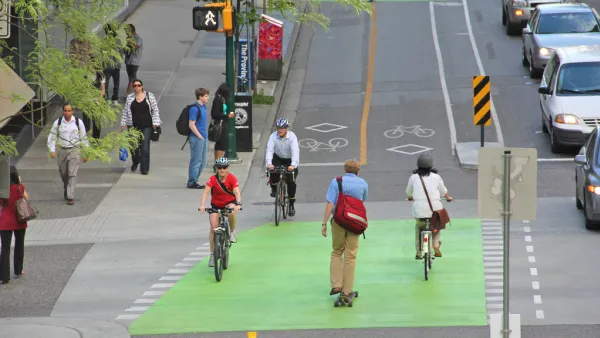A near-unanimous response to this week’s question on National Journal's Transportation Experts Blog was that we are far from being intermodal.
A near-unanimous response to this week's question on National Journal's Transportation Experts Blog was that we are far from being intermodal.
National Journal Transportation Experts Blog Weekly Summary
NOTE: Each week, some 80 invited "Beltway Insiders," including members of Congress, governors, state and local transportation officials, senior executives of trade associations, environmentalists and respected transportation professionals, debate current transportation issues on National Journal's Transportation Expert Blog. Pursuant to an agreement between Planetizen and the National Journal, weekly summaries of this dialogue will henceforth be posted on "Interchange." The summaries will be prepared by Ken Orski, a regular participant in the National Journal 's Transportation Blog and an occasional contributor to Planetizen's blog. Read more and see the full list of contributors at the National Journal Transportation Experts Blog.
According to Jeffrey Shane, former Undersecretary for Policy at U.S. Department of Transportation and currently partner of the Washington law firm of Hogan & Hartson, despite all the initiatives in the interest of intermodal institutions (e.g. establishment of a single federal Department of Transportation) and intermodal policies (e.g. creation of an Office of Intermodalism and a National Intermodal Transportation Commission), our federal transportation program remains stubbornly mode-specific. The federal funds are apportioned to each mode and each mode's users insist that their money be reserved for that mode- wholly predictable and entirely understandable, but arguably the very antithesis of an intermodal approach to transportation, says Shane. "My own view," writes Shane," is that we probably will never alter the current mode-centric structure of federal transportation programs." But that's no reason to despair, Shane continues. U.S. DOT can break down the modal barriers by identifying and supporting major multimodal projects of regional or national significance and reducing the programmatic impediments to their financing and delivery.
Strengthening intermodalism within USDOT is also a recommendation offered by Steve Van Beek, President of the Eno Transportation Foundation and former Director of Intermodalism at USDOT. There must be someone in the Office of the Secretary to act as an intermodal and multimodal advocate, Van Beek argues. His job should include ensuring that modal regulations and policies are not irrationally getting in the way of multimodal solutions (e.g. current rules restrict airports from using their revenue on airport access projects). Rich Sarles, Executive Director of NJ TRANSIT, is of the same opinion. "Congressional leadership and the Obama Administration would be wise to place intermodalism and multimodalism at the top of the policy and planning agenda," he writes. Moreover, a new funding category should be considered for projects that are multimodal and do not fit the standard modal mold.
Developing a national strategic transportation plan with an intermodal and multi-modal perspective must be one of the priorities of the next surface transportation reauthorization bill, writes Rep. John L. Mica (R-FL), Ranking Member of the House Committee on Transportation and Infrastructure. We must utilize the strengths of our various transportation modes in a way that makes the entire system stronger and more efficient. We must develop not just a better highway system or a better aviation system or a better rail system but a better transportation system, Mica contends.
If we are looking to promote a more integrated and intermodal system in the next surface transportation bill, the flexibility provided in the stimulus bill is a great model to follow, suggest Ed Hamberger, President of the Association of American Railroads and Geraldine Knatz, Executive Director of the Port of Los Angeles. The bill gave states the ability to spend their infrastructure investment dollars not just on highways and bridges but on rail projects, avaiation and port projects. National strategic investments in infrastructure must be based on a comprehensive intermodal plan that takes into account freight flows.

Analysis: Cybertruck Fatality Rate Far Exceeds That of Ford Pinto
The Tesla Cybertruck was recalled seven times last year.

National Parks Layoffs Will Cause Communities to Lose Billions
Thousands of essential park workers were laid off this week, just before the busy spring break season.

Retro-silient?: America’s First “Eco-burb,” The Woodlands Turns 50
A master-planned community north of Houston offers lessons on green infrastructure and resilient design, but falls short of its founder’s lofty affordability and walkability goals.

Test News Post 1
This is a summary

Analysis: Cybertruck Fatality Rate Far Exceeds That of Ford Pinto
The Tesla Cybertruck was recalled seven times last year.

Test News Headline 46
Test for the image on the front page.
Urban Design for Planners 1: Software Tools
This six-course series explores essential urban design concepts using open source software and equips planners with the tools they need to participate fully in the urban design process.
Planning for Universal Design
Learn the tools for implementing Universal Design in planning regulations.
EMC Planning Group, Inc.
Planetizen
Planetizen
Mpact (formerly Rail~Volution)
Great Falls Development Authority, Inc.
HUDs Office of Policy Development and Research
NYU Wagner Graduate School of Public Service




























